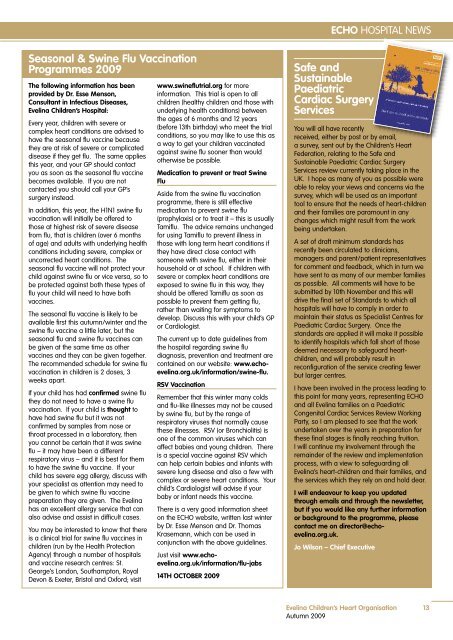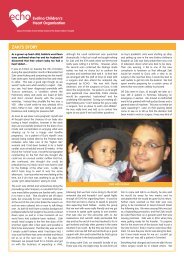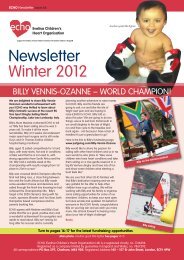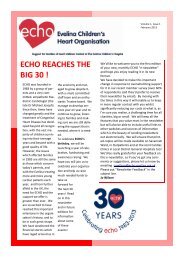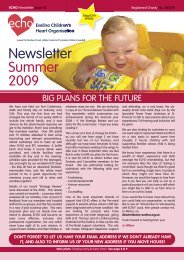ECHO Newsletter Autumn 2009 - Evelina Children's Heart ...
ECHO Newsletter Autumn 2009 - Evelina Children's Heart ...
ECHO Newsletter Autumn 2009 - Evelina Children's Heart ...
You also want an ePaper? Increase the reach of your titles
YUMPU automatically turns print PDFs into web optimized ePapers that Google loves.
<strong>ECHO</strong> CATRIONA’S STORY<br />
Catriona’s story<br />
My second pregnancy took me by surprise. Not the fact that I was<br />
expecting a second baby – but the fact that I wanted another child at<br />
all. Only a few months previously my husband and I had been quite<br />
convinced that we were happy to remain a little family of three. But as<br />
our daughter Abby started pre-school, we found ourselves wondering<br />
what another child would be like and we couldn’t resist.<br />
We were immediately excited at the<br />
prospect of our new baby, due in August<br />
2007. I felt well and had no real<br />
anxieties. Although I did fret to Ed, my<br />
husband, about the implications of<br />
having an August baby: ‘It’ll always be<br />
the youngest in its class at school.’ Ed, an<br />
August baby himself, raised an eyebrow<br />
and observed that it hadn’t done him too<br />
much harm.<br />
I knew straight away that I wanted to<br />
have this baby at St Thomas’ – our<br />
second closest hospital. We went for the<br />
12-week scan feeling like old hands. The<br />
scan, although technically the 12-week<br />
one, actually took place during the<br />
fourteenth week – too late for the nuchal<br />
test to determine the risk for Down<br />
syndrome and other chromosomal<br />
abnormalities. The sonographer<br />
recommended that I go for a blood test<br />
instead. But I didn’t bother. I couldn’t see<br />
what use the information would be: I had<br />
no intention of having anything so<br />
invasive as amniocentesis, and I already<br />
had a perfectly healthy child. I didn’t<br />
know anyone who had a child with a<br />
serious medical condition or a disability,<br />
so it wasn’t on my radar at all.<br />
When the time came for the 20-week<br />
scan – at 21 weeks – we took Abby<br />
along with us. We had told her all about<br />
the baby, and we thought it would be<br />
interesting for her to see the earliest<br />
pictures of her unborn brother or sister.<br />
But the sonographer said that she wasn’t<br />
getting very good pictures of the baby’s<br />
heart, and asked me to go for a walk to<br />
see if it would move into a more obliging<br />
position. So we walked around, and<br />
14 <strong>Evelina</strong> Children’s <strong>Heart</strong> Organisation<br />
<strong>Autumn</strong> <strong>2009</strong><br />
waited to be called back in, and waited<br />
some more. Waiting patiently isn’t really<br />
my thing, and I almost didn’t stay – Abby<br />
was getting bored, it was a sunny Friday<br />
afternoon, and I didn’t see the need to<br />
tick every box in the scan. We were<br />
called back in before I stomped off to the<br />
bus-stop – but I wonder what would<br />
have happened if I had?<br />
The sonographer told us that she<br />
couldn’t see four chambers of the baby’s<br />
heart, and that we should have a<br />
specialist cardiac scan, just to be on the<br />
safe side. I asked what it might mean, if<br />
she couldn’t see four chambers – but it<br />
wasn’t her job to give us that kind of<br />
information. She mumbled something<br />
unclear about a single atrium, gave us a<br />
date ten days away for the cardiac scan,<br />
and said goodbye. I cursed in the lift at<br />
the inadequacy of the information we’d<br />
been given, and at the limitations of the<br />
NHS, which was going to make us wait<br />
an agonising ten days to find out what<br />
the problem was. Then I stood outside St<br />
Thomas’ Hospital and cried – the first of<br />
many occasions I stood in the same spot<br />
and did the same thing.<br />
At home, I hit the internet. I didn’t know<br />
what to search for, but I finally found a<br />
phrase I thought I understood – ‘hole in<br />
the heart’. So our baby might have a<br />
hole in its heart. Well, that wasn’t so bad<br />
– lots of people had holes in their heart<br />
that corrected themselves. Not too much<br />
to worry about. Was there?<br />
But the next ten days of uncertainty were<br />
hard to get through. Ed reassured me<br />
that all was probably fine, that the baby<br />
had simply been lying the wrong way in<br />
the scan. But I knew from the<br />
sonographer’s demeanour that she<br />
wasn’t referring us for a cardiac scan<br />
simply as a formality. As we entered the<br />
<strong>Evelina</strong> for the first time on 23 April 2007,<br />
the world as we knew it changed.<br />
Emerging from the scan, we were shown<br />
into a small room, with tissues on the<br />
table. We were offered a cup of tea. Tea<br />
and tissues – how bad could it be? The<br />
situation outlined to us by Dr John<br />
Simpson was complex. Some of our<br />
baby’s heart problems were clear; some<br />
were not. There was an AVSD; there was<br />
a high chance of coarctation of the aorta;<br />
the left side of the heart was under-sized.<br />
We were trying to digest this, and trying<br />
to focus on Dr Simpson’s sketches of how<br />
the heart works, when he told us that<br />
this type of condition is often associated<br />
with chromosomal abnormality. All I<br />
could hear in my head was ‘Down<br />
syndrome’. And I could at that point<br />
imagine nothing worse than having a<br />
child with Downs – even though, in truth,<br />
I knew very little about what it really<br />
meant. But I feared for the impact of a<br />
disabled child on our family, doubted our<br />
ability to cope with such a child, and<br />
above all grieved for what it might mean<br />
for Abby, who was so excited about<br />
having a playmate. How could we<br />
change her life forever with a sibling who<br />
might always be highly dependent?<br />
Suddenly amniocentesis didn’t seem<br />
unacceptably invasive any more. This<br />
time we only had hours rather than days<br />
to wait for the test. Then an interminable<br />
48 hours while we waited for the first set<br />
of results. But we had no idea what we<br />
would do if we were told our unborn<br />
child had Down syndrome or some other<br />
abnormality. Ed and I talked about it, but<br />
reached no conclusions. I did more<br />
searching on the internet; went numbly<br />
to work; tried to imagine having a<br />
severely disabled child or having a<br />
termination at 23 weeks. Neither was<br />
imaginable.<br />
So when the call came, and I was told<br />
that no chromosomal abnormalities had<br />
been detected, I allowed myself to relax.<br />
Our baby would need surgery, but we<br />
would get through it.<br />
It was hard to stay relaxed though. I<br />
became preoccupied with whether the<br />
baby was growing properly and what<br />
other problems he or she might have.<br />
One of my consistent concerns was how<br />
still the baby seemed to be, how little it<br />
moved, and I wondered to Ed whether<br />
this baby would ever walk.<br />
I felt like I was on a different planet to<br />
other expectant mothers. Finding <strong>ECHO</strong><br />
was a big relief at this time, and the<br />
antenatal day we attended made us feel<br />
much less isolated. Being able to talk<br />
about what was happening with other<br />
people who were in the same situation<br />
helped us get through the final weeks,<br />
and I began to feel excited again.<br />
Another thing that helped was finding<br />
out that our unborn baby was a little girl.<br />
I needed a bit of help with thinking of this<br />
baby as a proper person and not just a<br />
collection of heart problems. And I<br />
figured that we’d have enough suspense<br />
on the day she was born. I was<br />
delighted to know that we were having<br />
another daughter, and it renewed my<br />
determination to do all I could to make<br />
everything come right for her.<br />
Amy’s arrival was strangely low-key. I<br />
had a planned caesarean due to her<br />
refusal (or perhaps, in retrospect,<br />
inability) to move out of breech position,<br />
and everything was in place – we put<br />
the date in our diaries, booked my<br />
mother to look after Abby, and took the<br />
bus to the hospital. It was all very<br />
different to the chaos of Abby’s birth at<br />
another south London hospital. Walking<br />
to theatre at 10.00am on 13 August 2007<br />
and climbing onto the operating table, I<br />
was as ready for this moment as I could<br />
ever be.<br />
Ed told me afterwards that the<br />
soundtrack in theatre was Babybird’s<br />
‘You’re gorgeous’ as Amy was lifted out<br />
into the world. She appeared<br />
immediately above the screen, moving<br />
her hands together as if she was about<br />
to burst into applause. It was an<br />
amazing moment – and even though I<br />
knew she couldn’t stay with me for long<br />
before going to intensive care, I had an<br />
overwhelming feeling that all would be<br />
well.<br />
Our baby girl looked perfect to us in<br />
every way, and she was soon deemed to<br />
be the healthiest baby in NICU. She<br />
didn’t need immediate surgery, and she<br />
quickly moved to SCBU where she lay in<br />
her cot looking totally self-contained and<br />
serene. We were amazed at her, and<br />
took her home at four days old<br />
with optimism<br />
outweighing our<br />
anxiety about<br />
her heart. Her<br />
cardiologist<br />
told us that<br />
he wanted<br />
her to<br />
grow a bit<br />
before<br />
surgery, and<br />
that he’d<br />
review her<br />
again in a<br />
few weeks.<br />
But Amy<br />
was only<br />
nine<br />
days<br />
old<br />
when<br />
we<br />
<strong>ECHO</strong> CATRIONA’S STORY<br />
noticed how fast she was breathing after<br />
feeding. We wanted to believe that it<br />
wasn’t significant, but our instincts took<br />
us back to St Thomas’. The rain poured<br />
down as I stood outside A&E, awash<br />
with tears and milk, as inside the<br />
hospital a junior doctor bent our tiny girl’s<br />
hand in a fruitless effort to insert a<br />
cannula. We were admitted to Savannah<br />
ward for the first time, and had our first<br />
opportunity to appreciate the calmness<br />
and kindness of the specialist nurses.<br />
Amy’s lungs were overloading as they<br />
struggled to cope with the volume of<br />
blood going back there, instead of<br />
pumping to the rest of her body. Diuretics<br />
were prescribed; Amy began to respond,<br />
and we gathered her up and went<br />
home. But now our peace of mind had<br />
gone – we were unable to relax fully<br />
around her, and we were constantly<br />
anxious. We began to realise that a big<br />
part of the challenge of being parents of<br />
a ‘heart-child’ is learning to manage<br />
anxiety and live with uncertainty.<br />
<strong>Evelina</strong> Children’s <strong>Heart</strong> Organisation 15<br />
<strong>Autumn</strong> <strong>2009</strong>


